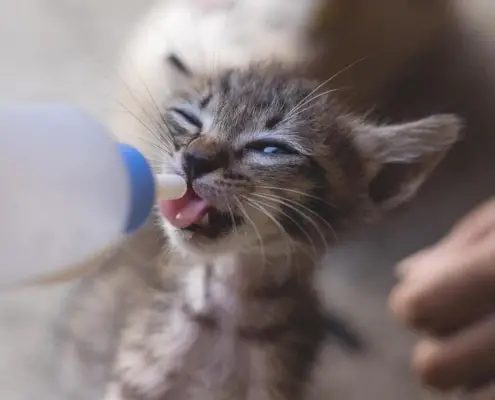
Cat allergies are a common concern for many individuals who love feline companions. An allergy to cats is triggered by proteins found in a cat’s fur, saliva, and urine, mainly Fel d 1. When these proteins are released into the air, they can cause allergic reactions in susceptible individuals. The body’s immune system mistakenly identifies these proteins as harmful invaders and releases chemicals, such as histamine, to defend against them. This immune response leads to the typical symptoms of cat allergies, including sneezing, runny or stuffy nose, itchy or watery eyes, and in some cases, skin rashes or hives.
Understanding the root cause of cat allergies is essential for effectively managing and mitigating their impact. While some individuals may experience mild symptoms, others may have severe reactions that significantly affect their quality of life. It’s important to recognize that cat allergies are not a result of a cat’s fur but rather the proteins present in a cat’s dander, saliva, and urine. By gaining a deeper understanding of cat allergies, individuals can take proactive steps to create a more allergy-friendly environment for themselves and their feline companions.
Symptoms of Cat Allergies
The symptoms of cat allergies can vary from mild to severe and may differ among individuals. Common signs of cat allergies often include sneezing, a runny or stuffy nose, itchy or watery eyes, and itching of the skin. In some cases, individuals may experience coughing, wheezing, or difficulty breathing, particularly if they have underlying respiratory conditions such as asthma. Skin reactions, such as redness, hives, or eczema, may also occur upon direct contact with a cat or exposure to surfaces where cat allergens are present.
It’s important to note that cat allergies can manifest differently in children and adults. Children may exhibit symptoms such as frequent rubbing of their eyes or nose, as well as a persistent cough. Adults, on the other hand, may experience more pronounced respiratory symptoms, including shortness of breath or chest tightness. Recognizing these symptoms is crucial for identifying potential cat allergies and taking appropriate measures to manage them effectively.
Common Misconceptions About Cat Allergies
There are several common misconceptions about cat allergies that can lead to misunderstanding and misinformation. One prevalent misconception is that certain cat breeds are hypoallergenic, meaning they are less likely to cause allergic reactions. While some cat breeds, or indeed individual cats, may produce fewer allergens or shed less fur, no cat is entirely hypoallergenic. All cats produce allergens, and individuals with cat allergies may react to any cat, regardless of its breed or coat type. Studies are currently being done to eliminate allergy-causing proteins from cats through gene editing, which would produce a truly hypoallergenic cat.
Another misconception is that cat hair is the primary cause of allergies. In reality, cat allergens are primarily found in a cat’s dander, which consists of tiny, often-invisible flecks of skin shed by the animal. These allergens can also be present in a cat’s saliva and urine, which can spread to the fur and skin during grooming. As a result, simply avoiding contact with a cat’s fur may not be sufficient to prevent allergic reactions.
Creating an Allergy-Friendly Environment for Your Cat
Creating an allergy-friendly environment for your cat involves implementing strategies to reduce the presence of allergens in your home.
While regular grooming of your cat can help minimize the amount of dander and saliva on their fur, thereby decreasing the spread of allergens, this should be done in a well-ventilated area, as grooming also releases Fel d 1 into the air.
Bathing your cat occasionally can be beneficial, although it’s essential to use products specifically designed for feline skin to avoid drying out their coat and skin, which would increase the release of dander. The levels of Fel d 1 on the cat’s fur returns to normal within two days, and levels of Fel d 1 in ambient air returns to normal within one day. Bathing is therefore not a long-term solution.
In addition to grooming, maintaining a clean and well-ventilated living space can contribute to reducing allergens. Vacuuming carpets, upholstery, and other surfaces regularly with a high-efficiency particulate air (HEPA) filter vacuum cleaner can help reduce allergens in the environment. Using allergen-proof bedding covers and regularly washing bedding at high temperatures can further minimize allergen exposure. Furthermore, keeping the home free of dust and mold can complement efforts to create an allergy-friendly environment for both you and your cat.
Tips for Reducing Allergens in Your Home
In addition to specific measures for cat care, there are various general strategies for reducing allergens in your home. Implementing a comprehensive cleaning routine that includes dusting, mopping, and wiping down surfaces can help minimize the accumulation of allergens. Using air purifiers with HEPA filters can effectively capture airborne allergens, improving indoor air quality. It’s also advisable to keep humidity levels in check, as high humidity can promote the growth of mold and dust mites, exacerbating allergic reactions.
Furthermore, minimizing the presence of fabrics and textiles that can trap allergens, such as curtains and upholstered furniture, can contribute to a more allergy-friendly environment. Opting for smooth, easy-to-clean surfaces and regularly laundering fabric items can help reduce allergen buildup. By integrating these tips into your household maintenance routine, you can create a more comfortable and allergen-reduced living space for both you and your cat.
Hypoallergenic Cat Breeds
While no cat breed is entirely hypoallergenic, certain breeds are known to produce fewer allergens or shed less fur, making them potentially more suitable for individuals with cat allergies. Some of these breeds include the Balinese, Russian Blue, and Sphynx. These cats may be less likely to trigger allergic reactions in some individuals, although it’s important to note that individual responses to specific cat breeds can vary.
When considering a hypoallergenic cat breed, it’s advisable to spend time with the cat in question to assess your personal reaction. Visiting a breeder or a shelter and interacting with the cat can provide valuable insight into how your body responds to a particular breed. Additionally, discussing your allergies with breeders or rescue organizations can help you make an informed decision about the compatibility of a specific cat breed with your individual allergy concerns.
Managing Cat Allergies While Living with a Feline Friend
Living with a cat while managing cat allergies requires a proactive approach to minimize allergen exposure and reduce the risk of allergic reactions. Regularly washing your hands after handling your cat, particularly before touching your face or eyes, can help prevent the transfer of allergens. Creating designated cat-free zones in your home, such as the bedroom, can provide allergy-free spaces where you can retreat to minimize exposure to cat allergens.
Using high-efficiency air filters in your home’s heating, ventilation, and air conditioning (HVAC) system can help reduce airborne allergens, improving indoor air quality. Additionally, incorporating allergen-reducing products, such as air purifiers and allergen-trapping bedding covers, can further aid in managing cat allergies while living with a feline companion. By implementing these strategies, individuals can enjoy the companionship of their cat while minimizing the impact of cat allergies on their daily lives.
Cat Allergy Treatments and Medications
For individuals with cat allergies, various treatments and medications are available to alleviate symptoms and improve quality of life. Over-the-counter antihistamines can help reduce sneezing, itching, and other allergic reactions. Nasal corticosteroid sprays can be effective in relieving nasal congestion and inflammation, while decongestants can help alleviate nasal congestion, although they should be used with caution due to potential side effects.
Allergen-specific immunotherapy (ASIT), or allergy shots, is another option for managing cat allergies. This treatment involves gradually desensitizing the immune system to cat allergens through regular injections under the supervision of an allergist. Immunotherapy can lead to long-term reduction in allergy symptoms and may be recommended for individuals with severe or persistent cat allergies. It’s essential to consult with a healthcare professional to determine the most suitable treatment approach based on individual allergy severity and medical history.
Studies are being conducted to disable the function of Fel d 1 on the human immune system by amending it through vaccines delivered to the cat. HypoCat™ is one such vaccine that can be administered to cats.
Other studies are being conducted to reduce Fel d 1 levels secreted by cats through their diet. One study concluded that “Feeding sIgY significantly reduced aFel d 1 in the saliva of cats within 3 weeks.”
When to Seek Professional Help for Cat Allergies
While self-care measures and over-the-counter medications can provide relief for mild cat allergies, it’s important to seek professional help if symptoms are persistent, severe, or significantly impact daily life. Consulting an allergist or immunologist can help individuals receive a comprehensive evaluation of their allergies and develop personalized management strategies. Allergy testing can identify specific allergens, including those related to cats, and guide targeted treatment approaches.
Additionally, individuals with underlying respiratory conditions such as asthma should seek professional guidance for managing cat allergies, as allergic reactions can exacerbate existing respiratory symptoms. Healthcare professionals can provide valuable guidance on minimizing allergen exposure, selecting appropriate medications, and incorporating lifestyle modifications to effectively manage cat allergies. By proactively seeking professional help, individuals can gain a deeper understanding of their cat allergies and access tailored support for optimal symptom management.
Conclusion
Cat allergies are a common concern for individuals who share their lives with feline companions. By understanding the root cause of cat allergies, recognizing common symptoms, and dispelling misconceptions, individuals can take proactive steps to create an allergy-friendly environment for themselves and their cats. Implementing strategies to reduce allergens in the home, exploring hypoallergenic cat breeds, and managing cat allergies while living with a feline friend can contribute to a harmonious and supportive coexistence.
Furthermore, individuals with cat allergies can explore various treatment options and seek professional help to effectively manage their symptoms and improve their quality of life. By integrating these insights and practices, individuals can navigate the challenges of cat allergies while fostering a loving and fulfilling relationship with their feline companions.
If you enjoyed my article, I would appreciate you sharing it with your network.

Sima Ndlebe
Sima writes for CatBuzz. He is interested in Cats, Health and Fitness, and Entrepreneurship.
Published: 16 October 2023
Related Articles
Disclaimer
The content found on CatBuzz.org is presented on an "as is" basis and is intended for general consumer information and education purposes only. Any utilization of this information is voluntary and solely at the user's own risk.
None of the articles or content should be regarded as, or used in place of, veterinary medical advice, diagnosis, or treatment. The information provided on the website is purely for educational and informational intentions and should not be considered a substitute for professional guidance from a veterinarian or other qualified expert. The articles are designed to inform consumers about veterinary healthcare and medical matters that may impact their cat's daily life. It should be noted that this website and its services do not constitute the practice of any form of veterinary medical advice, diagnosis, or treatment. CatBuzz.org explicitly disclaims any liability for any direct or indirect damages or losses that may arise from the use of or reliance on the information contained within the content.
Consumers must consult a veterinarian, veterinary specialist, or another qualified veterinary healthcare provider when seeking advice regarding their cat's health or medical conditions. It is important not to ignore, avoid, or postpone seeking medical advice from a veterinarian or other qualified veterinary healthcare provider solely based on information obtained from this website. If you believe that your cat may be experiencing a medical issue or condition, it is imperative to promptly contact a qualified veterinary healthcare professional.



